Spatial Analysis of Conservation Priorities Based on Ecosystem Services in the Atlantic Forest Region of Misiones, Argentina
Abstract
:1. Introduction
- (1) To identify priority areas for conservation of ecosystem services and habitat, and to analyze their spatial overlap.
- (2) To analyze the efficiency of existing protected areas and other important lands in conserving areas with high overlap of ecosystem services and habitat.
2. Material and Methods
2.1. Study Area
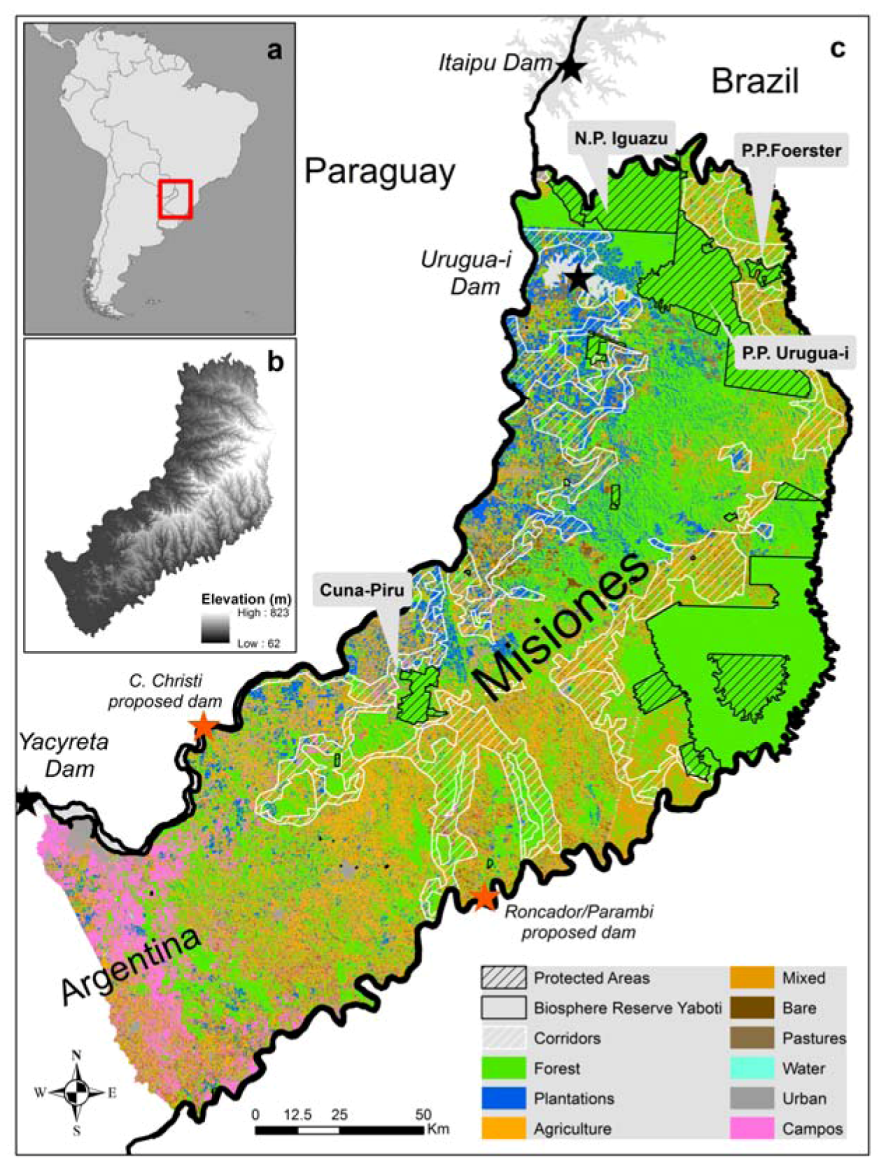
2.2. MARXAN Analysis
2.2.1. Selection and Model of the Conservation Targets
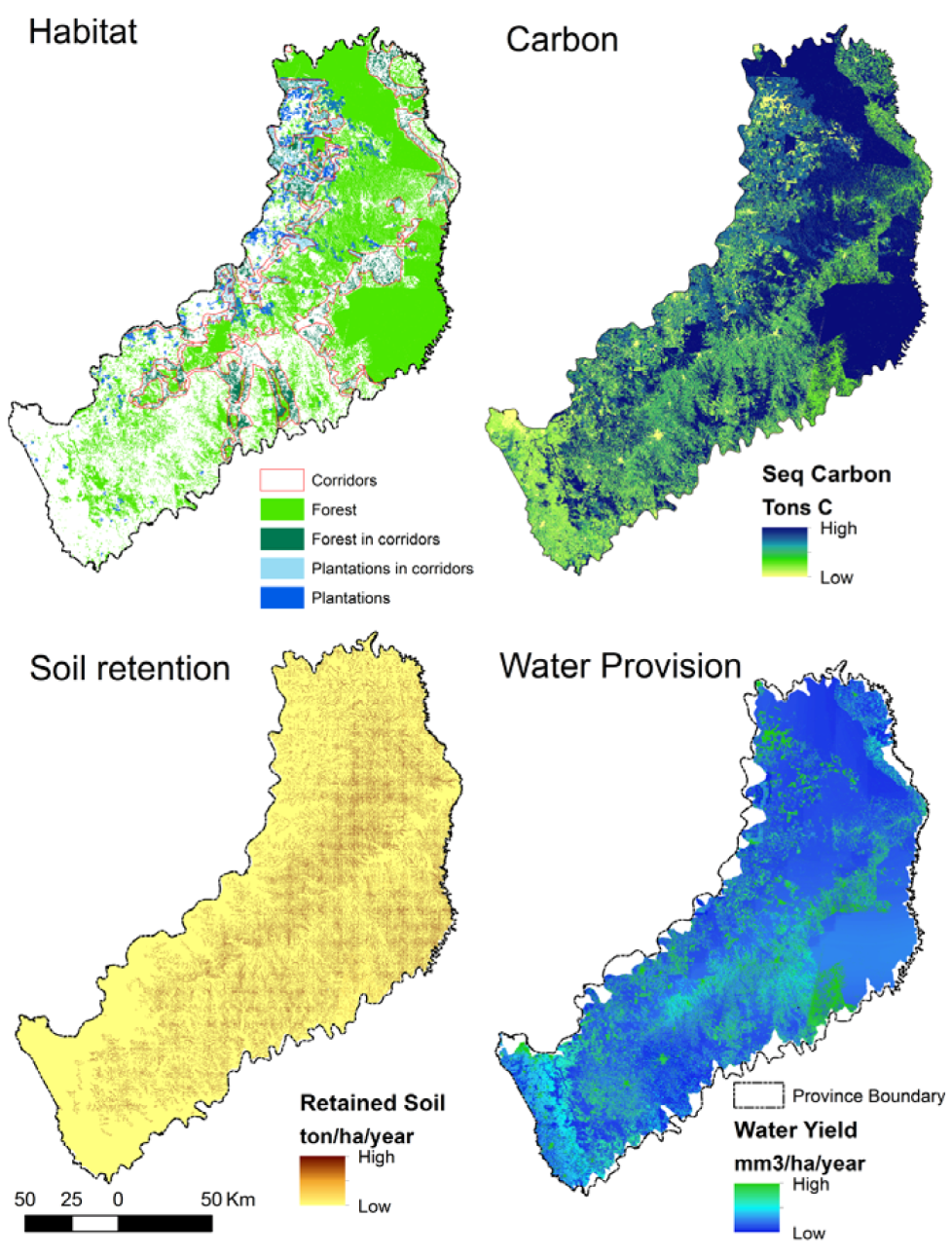
2.2.2. Other Parameterization of Marxan Analysis
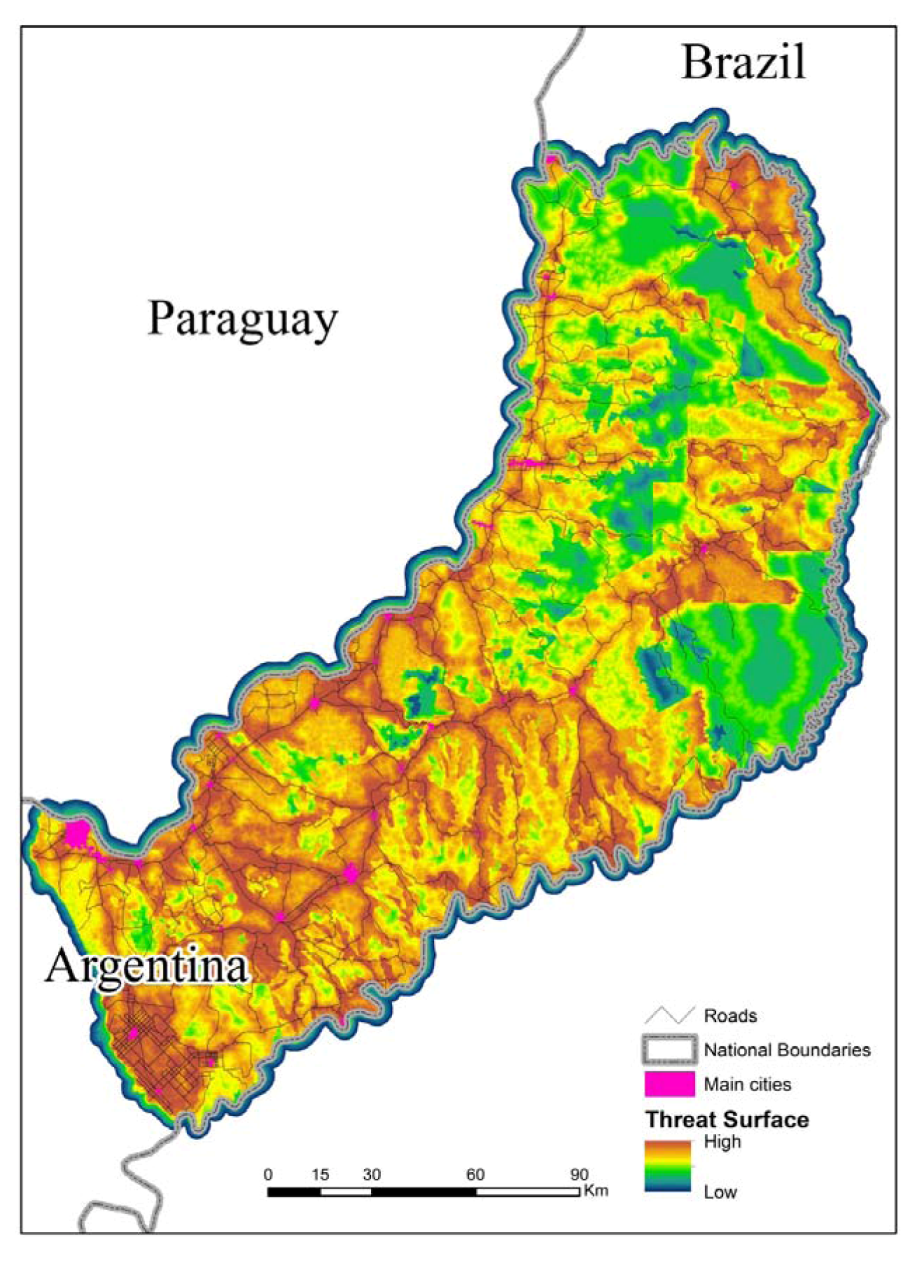
| Threat types | Weight’s WWF team | Mapped elements | Parameters | |
|---|---|---|---|---|
| Intensity | Distance (m) | |||
| Frontiers expansion | High | Soil agriculture suitability1 | ||
| • Suitable soil | 100 | 0 | ||
| • Medium suitability | 50 | 0 | ||
| • Unsuitable soil | 25 | 0 | ||
| Agricultural practices2 | ||||
| • Subsistence farming (tobacco and other annual crops) | 80 | 2000 | ||
| • Industrial crops (yerba and tea) | 50 | 1000 | ||
| • Pastures | ||||
| • Forest Plantations | 50 | 1000 | ||
| • Fire frequency | ||||
| Low (1–3) | 10 | 100 | ||
| Medium (4–9) | 25 | 100 | ||
| High(10–16) | 50 | 100 | ||
Extractive activities
| High to medium | Highways and roads3 | ||
| • Highways paved | 75 | 3000 | ||
| • Highways unpaved | 50 | 3000 | ||
| • Roads | 25 | 3000 | ||
| Main rivers4 | 75 | 3000 | ||
| Density rural population5 | ||||
| • Low density (0–5 people/km2) | 25 | 0 | ||
| • Medium density (5–10) | 75 | 0 | ||
| • High density (10–19) | 100 | 0 | ||
| Housing & urban areas | Low | Urban areas6 | ||
| • 2000–5000 people | 10 | 3000 | ||
| • 5000–10,000 people | 15 | 3000 | ||
| • >10,000 people | 25 | 3000 | ||
2.3. Marxan Analysis and Summary
3. Results and Discussion
3.1. Priority Areas for Conservation of Ecosystem Service, and Their Overlap.
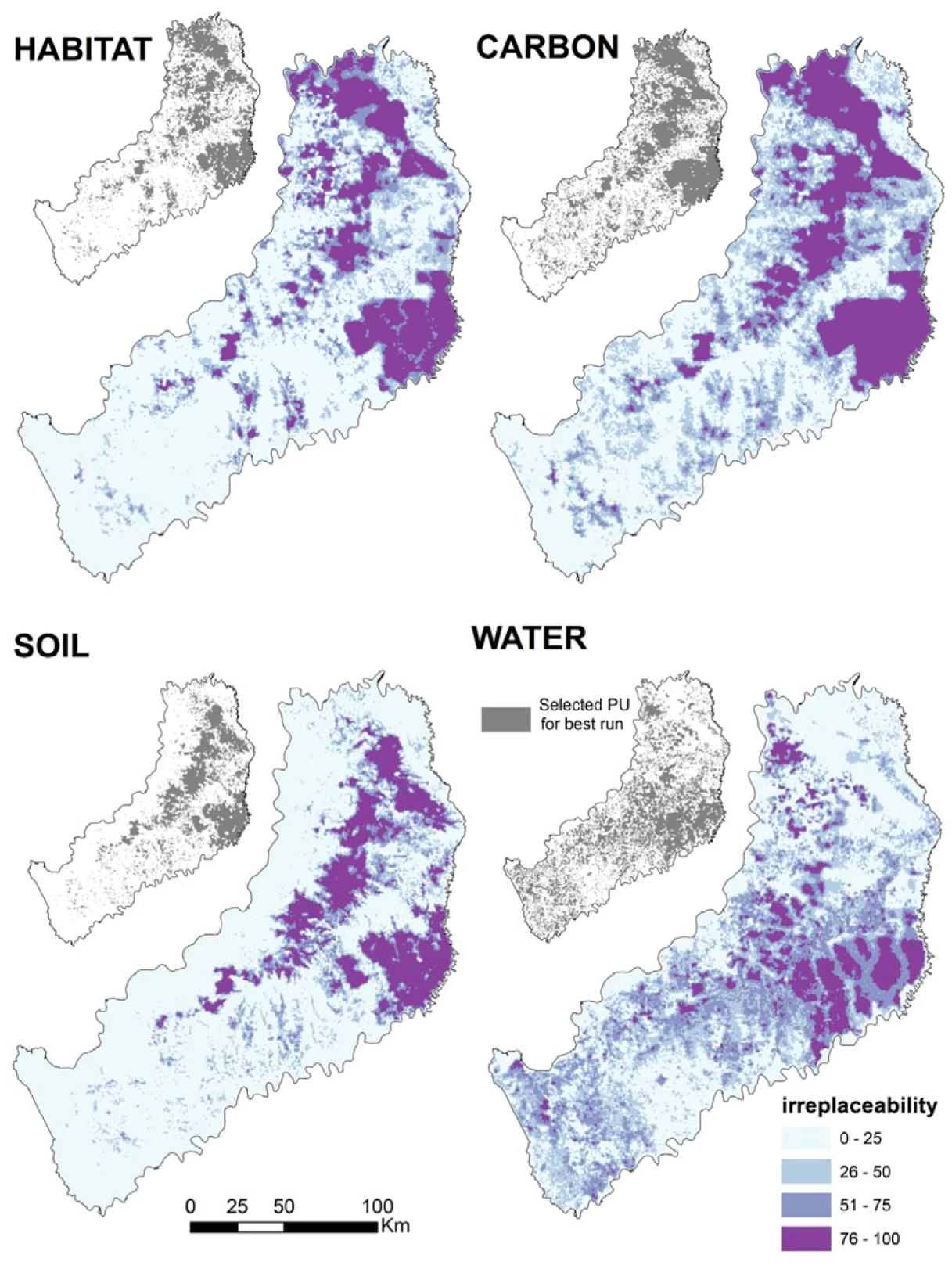
| Targets | Habitat | Carbon | Soil | Water |
|---|---|---|---|---|
| Habitat | 1 | |||
| Carbon | 0.89 | 1 | ||
| Soil | 0.68 | 0.60 | 1 | |
| Water | −0.09 | −0.10 | 0.17 | 1 |
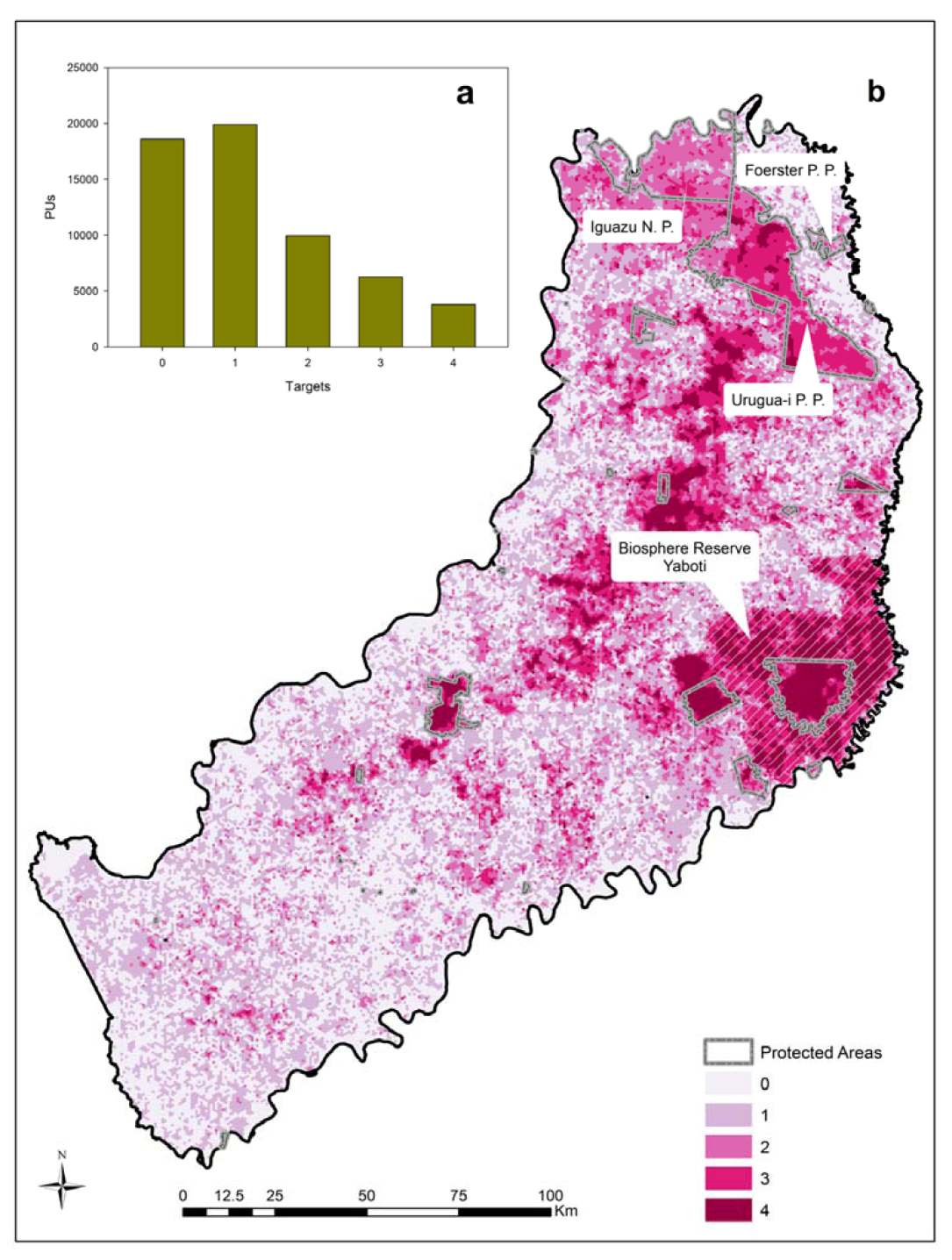
3.2. Ecosystem Services Provided by Landscape Components: Protected Areas, Areas of Conservation Interest, and the Matrix
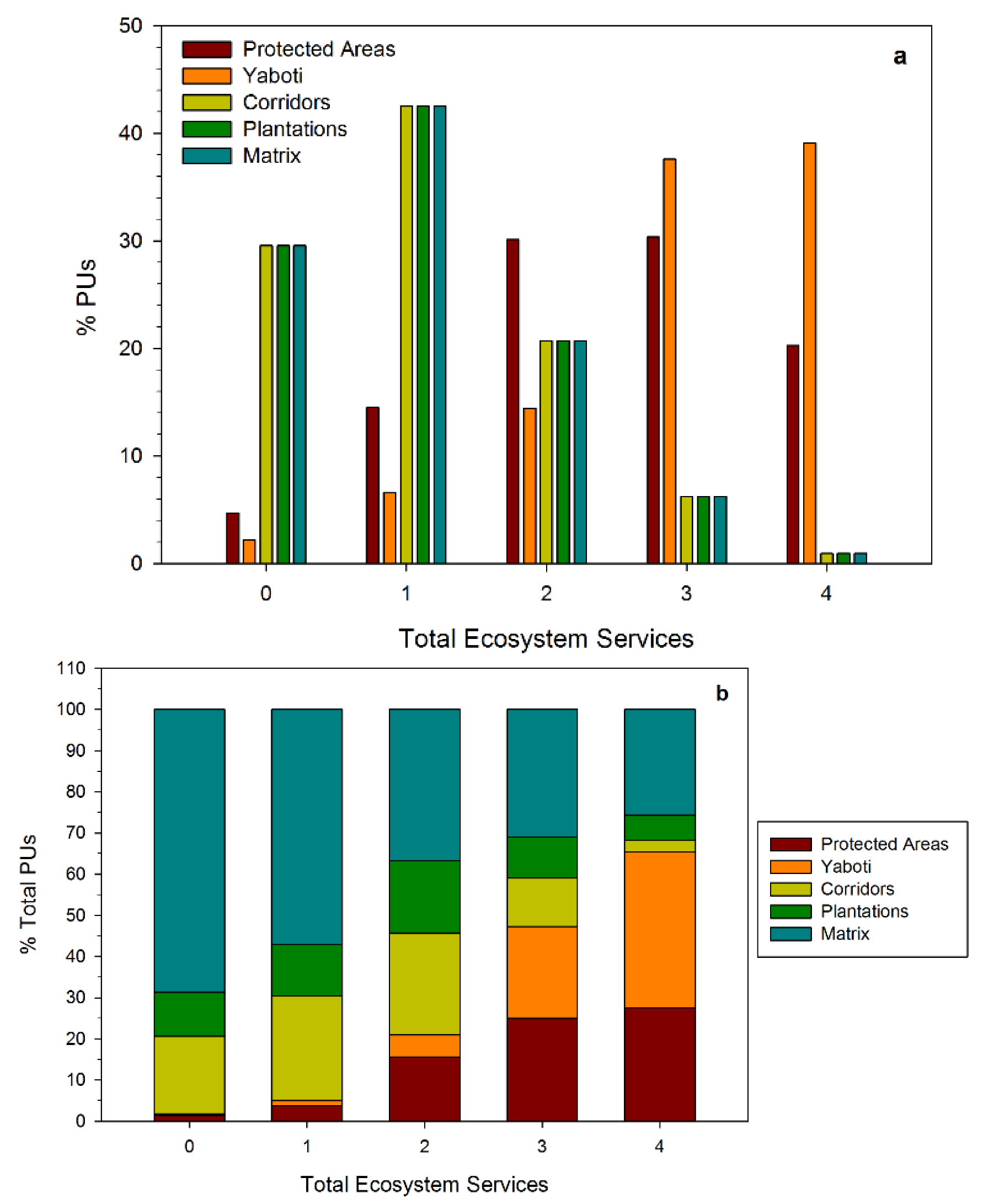
4. Conclusions
Conflict of Interest
Acknowledgments
References
- Brooks, T.M.; Mittermeier, R.A.; da Fonseca, G.A.B.; Gerlach, J.; Hoffmann, M.; Lamoreux, J.F.; Mittermeier, C.G.; Pilgrim, J.D.; Rodrigues, A.S.L. Global biodiversity conservation priorities. Science 2006, 313, 58–61. [Google Scholar]
- Paviolo, A.; de Angelo, C.D.; di Blanco, Y.E.; di Bitetti, M.S. Jaguar Pantheraonca population decline in the Upper Paraná Atlantic Forest of Argentina and Brazil. Oryx 2008, 42, 554–561. [Google Scholar] [CrossRef]
- Paviolo, A.; di Blanco, Y.E.; de Angelo, C.D.; di Bitetti, M.S. Protection affects the abundance and activity patterns of pumas in the Atlantic Forest. J. Mammal. 2009, 90, 926–934. [Google Scholar] [CrossRef]
- Daily, G.C. Nature’s Services: Societal Dependence on Natural Ecosystem Services, 1st ed; Island Press: Washington, DC, USA, 1997. [Google Scholar]
- Millennium Ecosystem Assessment (MEA). Ecosystems and Human Well-Being: Biodiversity Synthesis; World Resource Institute: Washington, DC, USA, 2005. Available online: http://www.millenniumassessment.org/documents/document.354.aspx.pdf (accessed on 13 August 2012).
- Turner, W.R.; Brandon, K.; Brooks, T.M.; Costanza, R.; da Fonseca, G.A.B.; Portela, R. Global conservation of biodiversity and ecosystem services. BioScience 2007, 57, 868–873. [Google Scholar] [CrossRef]
- Pimm, S.L.; Russell, G.J.; Gittleman, J.L.; Brooks, T.M. The future of biodiversity. Science 1995, 269, 347–350. [Google Scholar]
- Rodriguez, A.S.L.; Akçakaya, H.R.; Andelman, S.J.; Bakarr, M.I.; Boitani, L.; Brooks, T.M.; Cjanson, J.S.; Fishpool, L.D.C.; da Fonseca, G.A.B.; Gaston, K.J.; Hoffmann, M.; Marquet, P.A.; Pilgrim, J.D.; Pressey, R.L.; Schipper, J.; Secrest, W.; Stuart, S.N.; Underhill, L.; Waller, R.W.; Watts, M.E.J.; Yan, X. Global gap analysis: Priority regions for expanding the global protected-area network. BioScience 2004, 54, 1092–1100. [Google Scholar]
- Bailey, N.; Lee, J.C.; Thompson, S. Maximizing the natural capital benefits of habitat creation: Spatially targeting native woodland using GIS. Landsc. Urban Plan. 2006, 75, 227–243. [Google Scholar] [CrossRef]
- Margules, C.R.; Pressey, L.R. Systematic conservation planning. Nature 2000, 405, 243–253. [Google Scholar] [CrossRef]
- Izquierdo, A.E.; Grau, H.R. Agriculture adjustment, land-use transition and protected areas in Northwestern Argentina. J. Environ. Manag. 2009, 90, 858–865. [Google Scholar] [CrossRef]
- Waggoner, P.E.; Ausubel, J.H. How much feeding more and wealthier people will encroach on forests? Popul. Dev. Rev. 2001, 27, 239–257. [Google Scholar]
- Grau, H.R.; Gasparri, N.I.; Aide, T.M. Land use efficiency: Balancing food production and nature conservation in neotropical dry forests of NW Argentina. Glob. Chang. Biol. 2008, 14, 985–997. [Google Scholar] [CrossRef]
- Balmford, A.; Green, R.E.; Scharlemann, J.P.W. Sparing land for nature: Exploring the potential impact of changes in agricultural yield on the area needed for crop production. Glob. Chang. Biol. 2005, 11, 1594–1605. [Google Scholar] [CrossRef]
- Grau, H.R.; Aide, T.M. Globalization and land-use transitions in Latin America. Ecol. Soc. 2008, 13. Available online: http://www.ecologyandsociety.org/vol13/iss2/art16/ (accessed on 13 August 2012).
- Phalan, B.; Onial, M.; Balmford, A.; Green, R.E. Reconciling food production and biodiversity conservation: Land sharing and land sparing compared. Science 2011, 333, 1289–1291. [Google Scholar] [CrossRef]
- Matson, P.A.; Vitousek, P.M. Agricultural intensification: Will land spared from farming be land spared for nature? Conserv. Biol. 2006, 20, 709–710. [Google Scholar] [CrossRef]
- Perfecto, I.; Vandemeer, J. Biodiversity conservation in tropical agroecosystems. Ann. N. Y. Acad. Sci. 2008, 1134, 173–200. [Google Scholar] [CrossRef]
- Daily, G.C.; Kareiva, P.M.; Polasky, S.; Ricketts, T.H.; Tallis, H. Mainstreaming natural capital into decisions. In Natural Capital: Theory and Practice of Mapping Ecosystem Services, 1st; Kareiva, P., Tallis, H., Ricketts, T.H., Daily, G.C., Polasky, S., Eds.; Oxford University Press: Oxford, UK, 2010; pp. 3–14. [Google Scholar]
- Bruner, A.G.; Gullison, R.E.; Balmford, A. Financial costs and shortfalls of managing and expanding protected-area Systems in developing countries. BioScience 2004, 54, 1119–1126. [Google Scholar] [CrossRef]
- Naidoo, R.; Bamford, A.; Costanza, R.; Fisher, B.; Green, R.E.; Lehner, B.; Malcom, T.R.; Ricketts, T.H. Global mapping of ecosystem services and conservation priorities. Proc. Natl. Acad. Sci. USA 2008, 105, 9495–9500. [Google Scholar]
- Balmford, A.; Gaston, K.J.; Blyth, S.; James, A.; Kapos, V. Global variation in terrestrial conservation costs, conservation benefits, and unmet conservation needs. Proc. Natl. Acad. Sci. USA 2003, 100, 1046–1050. [Google Scholar]
- Ball, I.R.; Possingham, H.P.; Watts, M. Spatial Conservation Prioritisation: Quantitative Methods and Computational Tools; Moilanen, A., Wilson, K.A., Possingham, H.P., Eds.; Oxford University Press: Oxford, UK, 2009; p. 185. [Google Scholar]
- Airame, S.; Dugan, J.E.; Lafferty, K.D.; Leslie, H.; McArdle, D.A.; Warner, R.R. Applying ecological criteria to marine reserve design: A case study from the California Channel Islands. Ecol. Appl. 2003, 13, 170–184. [Google Scholar] [CrossRef]
- Jenkins, C.N.; Giri, C. Protection of mammal diversity in Central America. Conserv. Biol. 2008, 22, 1037–1044. [Google Scholar] [CrossRef]
- Fraschetti, S.; D’Ambrosio, P.; Micheli, F.; Pizzolante, F.; Bussotti, S.; Terlizzi, A. Design of marine protected áreas in a human-dominated seascape. Mar. Ecol. Prog. Ser. 2009, 375, 13–24. [Google Scholar] [CrossRef]
- Loss, S. Marxan analyses and prioritization of conservation areas for the central interior ecoregional assessment. BC J. Ecosyst. Manag. 2009, 12, 88–97. [Google Scholar]
- Chan, K.M.A.; Shaw, M.R.; Cameron, D.R.; Underwood, E.C.; Daily, G.C. Conservation planning for ecosystem services. PLoS Biol. 2006, 4, 2138–2152. [Google Scholar]
- Di Bitetti, M.S.; Placci, G.; Dietz, L.A. A Biodiversity Vision for the Upper Paraná Atlantic Forest Eco-Region: Designing a Biodiversity Conservation Landscape and Setting Priorities for Conservation Action; World Wildlife Fund: Washington, DC, USA, 2003; p. 156. [Google Scholar]
- Hoekstra, J.M.; Boucher, T.M.; Ricketts, T.H.; Roberts, C. Confronting a biome crisis: Global disparities of habitat loss and protection. Ecol. Lett. 2005, 8, 23–29. [Google Scholar]
- Myers, N.; Mittermeier, R.A.; Mittermeier, C.G.; da Fonseca, G.A.B.; Kent, J. Biodiversity hotspots for conservation priorities. Nature 2000, 403, 853–858. [Google Scholar]
- Mittermeier, R.A.; Robles-Gil, P.; Hoffmann, M.; Pilgrim, J.D.; Brooks, T.M.; Mittermeier, C.G.; Lamoreux, J.L.; Fonseca, G. Hotspots Revisited: Earth’s Biologically Richest and Most Endangered Terrestrial Ecoregions; CEMEX: Mexico City, Mexico, 2005; p. 392. [Google Scholar]
- Olson, D.M.; Dinerstein, E.; Wikramanayake, E.D.; Burgess, N.D.; Powell, G.V.N.; Underwood, E.C.; D’amico, J.A.; Itoua, I.; Strand, H.E.; Morrison, J.C.; Loucks, C.J.; Allnutt, T.F.; Ricketts, T.H.; Kura, Y.; Lamoreux, J.F.; Wettengel, W.W.; Hedao, P.; Kassem, K. Terrestrial Ecoregions of the world: A new map of life on earth. BioScience 2001, 51, 933–938. [Google Scholar]
- Izquierdo, A.E.; de Angelo, C.D.; Aide, T.M. Thirty years of human demography and land-use change in the Atlantic Forest of Misiones, Argentina: An evaluation of the forest transition model. Ecol. Soc. 2008, 13. Available online: http://www.ecologyandsociety.org/vol13/iss2/art3/ (accessed on 13 August 2012).
- Izquierdo, A.E.; Grau, H.R.; Aide, T.M. Implications of rural-urban migration for conservation of the Atlantic Forest and urban growth in Misiones, Argentina (1970–2030). AMBIO J. Hum. Environ. 2011, 40, 298–309. [Google Scholar] [CrossRef]
- Gasparri, N.I.; Grau, H.R. Patrones regionales de deforestación en el subtrópico argentino y su contexto ecológico y socioeconómico (in Spanish). In Situación Ambiental Argentina; Brown, A.D., Martinez, O.U., Acerbi, M., Corchera, J., Eds.; Fundación Vida Silvestre: Buenos Aires, Argentina, 2006; pp. 442–446. [Google Scholar]
- Giraudo, A.R.; Krauczuk, E.; Arzamendia, V.; Povedano, H. Critical analysis of protected areas in the Atlantic Forest of Argentina. In The Atlantic Forest of South America. Center for Applied Biodiversity Science; Galindo-Leal, C., de Gusmao, C.I., Eds.; Island Press: Washington, DC, USA, 2003; pp. 245–261. [Google Scholar]
- Fahey, C.; Langhammer, P.F. The effects of dams on biodiversity in the Atlantic Forest. In The Atlantic Forest of South America. Center for Applied Biodiversity Science; Galindo-Leal, C., de Gusmao, C.I., Eds.; Island Press: Washington, DC, USA, 2003; pp. 413–425. [Google Scholar]
- Fearnside, P.M. Hydroelectric dams in the Brazilian Amazon as sources of “green-house” gases. Environ. Conserv. 1995, 22, 7–19. [Google Scholar] [CrossRef]
- Game, E.T.; Grantham, H.S. Marxan User Manual: For Marxan Version 1.8.10.; University of Queensland: St. Lucia, Australia; Pacific Marine Analysis, 2008; Research Association: Vancouver, Canada. [Google Scholar]
- Fisher, B.; Turner, R.K.; Morling, P. Defining and classifying ecosystem services for decision making. Ecol. Econ. 2009, 68, 643–653. [Google Scholar] [CrossRef]
- Instituto Nacional de Tecnología Agropecuaria (INTA), Informe edafologico de la Provincia de Misiones, Republica Argentina (in Spanish); INTA: Corrientes, Argentina, 1964; p. 70.
- Lasserre, R.; Ríos, M.A. Evaluación de los Recursos del Suelo del Área de Frontera de la Provincia de Misiones (in Spanish); INTA: Corrientes, Argentina, 1983; p. 69. [Google Scholar]
- Ligier, H.D. Caracterización Geomorfológica y Edáfica de la Provincia de Misiones. Informe Para la Fundacion Vida Silvestre Argentina; INTA: Corrientes, Argentina, 2000. [Google Scholar]
- Placci, G.; DiBitetti, M.S. Situación ambiental de la ecorregion del Bosque Atlantico del Alto Parana (Selva Parananense). In Situación Ambiental Argentina; Brown, A.D., Martinez, O.U., Acerbi, M.C.J., Eds.; Fundación Vida Silvestre: Buenos Aires, Argentina, 2006; pp. 197–210. [Google Scholar]
- Facetti, J.F. The guaraní aquifer: A regional environmenal service. In The Atlantic Forest of South America. Center for Applied Biodiversity Science; Galindo-Leal, C., de Gusmao, C.I., Eds.; Island Press: Washington, DC, USA, 2003; pp. 325–327. [Google Scholar]
- Di Bitetti, M.S.; Paviolo, A.; Ferrari, C.; de Angelo, C.D.; di Blanco, Y.E. Differential responses to hunting in two sympatric species of brocket deer (Mazama americana and M. nana). Biotropica 2008, 40, 636–645. [Google Scholar] [CrossRef]
- Di Bitetti, M.S.; Paviolo, A.; de Angelo, C.D. Density, habitat use and activity patterns of ocelots (Leopardus pardalis) in the Atlantic Forest of Misiones, Argentina. J. Zool. 2006, 270, 153–163. [Google Scholar]
- Zurita, G.A.; Rey, N.; Varela, D.M.; Villagra, M.; Belock, M.I. Conversion of the Atlantic Forest into native and exotic tree plantations: Effects on bird communities from the local and regional perspectives. For. Ecol. Manag. 2006, 235, 164–173. [Google Scholar] [CrossRef]
- Tallis, H.T.; Ricketts, T.; Nelson, E.; Ennaanay, D.; Wolny, S.; Olwero, N.; Vigerstol, K.; Pennington, D.; Mendoza, G.; Aukema, J.; Foster, J.; Forrest, J.; Cameron, D.; Lonsdorf, E.; Kennedy, C. InVEST 1.005 Beta User’s Guide; The Natural Capital Project: Stanford, CA, USA, 2010. [Google Scholar]
- Gasparri, N.I.; Grau, H.R.; Manghi, E. Carbon pools and emissions from deforestation in extra-tropical forests of Northern Argentina between 1900 and 2005. Ecosystems 2008, 11, 1247–1261. [Google Scholar] [CrossRef]
- IPCC Guidelines for National Greenhouse Gas Inventories; Institute for Global Environmental 73 Strategies (IGES): Hayama, Japan, 2006. Available online: http://www.ipcc-nggip.iges.or.jp/public/2006gl/vol4.html (accessed on 13 August 2012).
- Houghton, R.A. Tropical deforestation as a source of greenhouse gas emissions. In Tropical Deforestation and Climate Change; Moutinho, P., Schwartzman, S., Eds.; Instituto de Pesquisa Ambiental da Amazonia and Environmental Defense: Belem, Brazil, 2005. [Google Scholar]
- Wischmeier, W.H.; Smith, D. Predicting Rainfall Erosion Losses: A Guide to Conservation Planning; US Department of Agriculture: Washington, DC, USA, 1978. [Google Scholar]
- Erosion Control as a Response to Various Erosion Processes; Natural Resources Management and Environment Department (FAO): Rome, Italy, 1996. Available online: http://www.fao.org/ (accessed on 13 August 2012).
- National Agricultural Technology Institute (INTA), Argentina. Available online: http://inta.gob.ar (accessed on 13 August 2012).
- Zhang, L.; Dawes, W.R.; Walker, G.R. Response of mean annual evapotranspiration to vegetation changes at catchment scale. Water Resour. Res. 2001, 37, 701–708. [Google Scholar] [CrossRef]
- Hijmans, R.J.; Cameron, S.E.; Parra, J.L.; Jones, P.G.; Jarvis, A. Very high resolution interpolated climate surfaces for global land areas. Int. J. Climatol. 2005, 25, 1965–1978. [Google Scholar] [CrossRef]
- United Nations Food and Agriculture Organization (FAO). GeoNetwork Spatial Data Portal. Available online: http://www.fao.org/geonetwork (accessed on 13 August 2012).
- National Agricultural Technology Institute (INTA), Atlas de Suelos de la República Argentina (in Spanish); INTA: Buenos Aires, Argentina, 1990.
- Integrated Hydrologic Data Base (BDHI). Available online: http://www.hidricosargentina.gov.ar/AccesoBDHI.html (accessed on 15 August 2012).
- National Institute of Statistics and Censuses (INDEC), Censo Nacional Agropecuario (in Spanish); INDEC: Buenos Aires, Argentina, 2002.
- Ardron, J.A.; Possingham, H.P.; Klein, C.J. Marxan Good Practices Handbook, Version 2; Pacific Marine Analysis and Research Association: Victoria, Canada, 2010. [Google Scholar]
- Schill, S.; Raber, G. Protected Area Tools (PAT) for ArcGIS 9.3TM, Version 3.0 User Manual and Tutorial; The Nature Conservancy: Arlington, VA, USA, 2009. [Google Scholar]
- World Wildlife Foundations (WWF)/Fundación Vida Silvestre Argentina (FVSA), Atlantic Forests, Ecoregional Action Plan (EAP) 2020: Zero-Deforestation Landscape; Working paper for WWF/FVSA: Washington, DC, USA, 2011.
- NASA Fire Information for Resource Management System (FIRMS), MODIS Hotspot/Active Fire Detections. Available online: http://earthdata.nasa.gov/firms (accessed on 15 August 2012).
- Digital Chart of the World (DCW) by the United States Defense Mapping Agency (DMA). Available online: http://www.diva-gis.org/gData (accessed on 15 August 2012).
- Available online: http://whc.unesco.org/en/statesparties/ar (accessed on 15 August 2012).
- New7Wonders Foundation. Available online: http://www.n7w.com (accessed on 15 August 2012).
- Balmford, A.; Green, R.; Phalan, B. What conservationists need to know about farming. Proc. Royal Soc. 2012, 279, 2714–2724. [Google Scholar] [CrossRef]
- Conservación Argentina Home Page. Available online: http://www.conservacion.org.ar/Nuestros-proyectos-corredor.htm (accessed on 15 August 2012).
- Giraudo, A.; Povedano, H. Threats of extinction to flagship species in the Interior Atlantic Forest. In The Atlantic Forest of South America: Center for Applied Biodiversity Science; Galindo-Leal, C., de Gusmao, C.I., Eds.; Island Press: Washington, DC, USA, 2003; pp. 181–193. [Google Scholar]
- Alcobe, F. Bosques de Alto Valor de Conservación-Yabotí, Informe Para Nativa, Misiones, Argentina. Personal communication, 2009.
- Bovarnick, A.; Fernández-Baca, J.; Galindo, J.; Negret, H. Sostenibilidad Financiera de las Áreas Protegidas en América Latina y el Caribe: Guía Para la Política de Inversión (in Spanish); Unite Nations Development Program and the Nature Conservancy: Arlington, VA, USA, 2010. [Google Scholar]
- Varela, D.D.; Jaramillo, M. Conservación Argentina, Puerto Iguazú (N3370FSC) and Fundación Vida Silvestre Argentina (FVSA), Misiones, Argentina. Personal communication, 2011.
- Angelsen, A.; Brown, S.; Loisel, C.; Peskett, L.; Streck, C.; Zarin, D. Reducing Emissions from Deforestation and Forest Degradation (REDD): An Options Assessment Report; Meridian Institute: Washington, DC, USA, 2009. [Google Scholar]
- Alix-Garcia, J.; de Janvry, A.; Sadoulet, E. The Role of Calibrated compensation and risk in designing payments for environmental services. Environ. Dev. Econ. 2008, 13, 375–394. [Google Scholar]
- Mayrand, K.; Paquin, M. Payments for Environmental Services: A Survey and Assessment of Current Schemes; Unisfera International Center: Montréal, Canada, 2004. Available online: http://www.cec.org/files/PDF/ECONOMY/PES-Unisfera_en.pdf (accessed on 13 August 2012).
© 2012 by the authors; licensee MDPI, Basel, Switzerland. This article is an open-access article distributed under the terms and conditions of the Creative Commons Attribution license (http://creativecommons.org/licenses/by/3.0/).
Share and Cite
Izquierdo, A.E.; Clark, M.L. Spatial Analysis of Conservation Priorities Based on Ecosystem Services in the Atlantic Forest Region of Misiones, Argentina. Forests 2012, 3, 764-786. https://doi.org/10.3390/f3030764
Izquierdo AE, Clark ML. Spatial Analysis of Conservation Priorities Based on Ecosystem Services in the Atlantic Forest Region of Misiones, Argentina. Forests. 2012; 3(3):764-786. https://doi.org/10.3390/f3030764
Chicago/Turabian StyleIzquierdo, Andrea E., and Matthew L. Clark. 2012. "Spatial Analysis of Conservation Priorities Based on Ecosystem Services in the Atlantic Forest Region of Misiones, Argentina" Forests 3, no. 3: 764-786. https://doi.org/10.3390/f3030764




